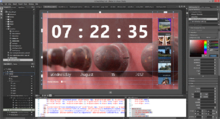 Blend for Visual Studio 2012 screenshot | |
| Developer(s) | Microsoft |
|---|---|
| Stable release | 2022 v17.7.2
/ 2022[1] |
| Operating system | Windows 7 and later[2] |
| Platform | DirectX[2] |
| License | Same as Visual Studio[3] |
| Website | visualstudio |
Microsoft Blend for Visual Studio (formerly Microsoft Expression Blend) is a user interface design tool developed and sold by Microsoft for creating graphical interfaces for web and desktop applications that blend the features of these two types of applications. It is an interactive, WYSIWYG front-end for designing XAML-based interfaces for Windows Presentation Foundation, Silverlight and UWP applications. It was one of the applications in the Microsoft Expression Studio suite before that suite was discontinued.
Expression Blend supports the WPF text engine with advanced OpenType typography and ClearType, vector-based 2D widgets, and 3D widgets with hardware acceleration via DirectX.
YouTube Encyclopedic
-
1/5Views:215 73313 3184 2073 958125 470
-
(3) Building your apps first User Interface using Blend and Visual Studio
-
Desktop Application Design in Blend For Visual Studio 2019 (Getting Started)
-
UI Design : XAML UI design in Visual studio blend 2019 | Login Animation | C# WPF
-
Blend for Visual Studio 2019 | Desktop Application Design
-
Visual Studio 2019 Launch: Build amazing web apps with .NET Core
Transcription
History
Expression Blend was code-named Sparkle, and originally the product was announced as Microsoft Expression Interactive Designer, before it was renamed Expression Blend in December 2006.
On January 24, 2007, Microsoft released the first public Community Technology Preview of Expression Blend as a free download on their web site. The final version was released to manufacturing along with other Expression products on 30 April 2007. The RTM news was announced at Microsoft's MIX 07 conference for web developers and designers.[4] Expression Blend Service Pack 1 was released in November 2007.[5] Expression Blend requires .NET Framework 3.0. Expression Blend and Expression Web are also available as part of the MSDN Premium subscription.
In December 2012 Microsoft announced that they were discontinuing the standalone Expression suite tools.[6][7] Expression Blend was integrated into Visual Studio 2012 and Visual Studio Express for Windows 8.
Release history
| Release | Release Date | Highlights |
|---|---|---|
| 2 | 2008-04-28 | Support developing Microsoft Silverlight browser-based rich web applications providing animation, vector graphics, interactivity and video playback capabilities. Version 2.0 supported only Silverlight 1.0 applications at release and Microsoft had planned Blend 2.5 for Silverlight 2.0 applications, however the capabilities of the preview version 2.5 have been added to Blend 2.0 Service Pack 1. |
| 3 | 2009-07-22 | Support for PSD and AI files, SketchFlow,[8] TFS support and number of other significant improvements. Sketchflow is a user experience prototyping module implemented in Blend.[9][10] |
| 4 | 2010-06-07 | Support for Silverlight 4 and WPF 4 while also remaining compatible with Silverlight 3 and WPF 3.5 SP1 applications. Other improvements and additions: shapes library, improved Photoshop file support, added pixel shader effects, path layout, transition effects, ListBox item transitions, Model-View-ViewModel pattern support, additional Behaviors, conditional Behaviors, sample data from CLR classes, design time resource resolution, easing functions for WPF 4, cleaner XAML, and .ZIP support for projects and templates.[11] Support for Windows Phone 7 projects to Expression Blend 4 Release Candidate.[12][13][14] |
| 2012 | 2012-08-15 | Name changed to "Blend for Visual Studio 2012". Released alongside the Windows 8 & Visual Studio 2012 RTMs. Includes support for WPF version 3.5, 4.0 and 4.5, Silverlight 4.0 and 5.0, SketchFlow, and Blend tools for Windows 8.[15][3][2] |
| 2013 | 2013-10-17 | Released alongside Visual Studio 2013 RTMs |
| 2015 | 2015-07-20 | Released alongside Visual Studio 2015 RTMs[16] |
| 2017 | 2017-03-07 | Released alongside Visual Studio 2017 RTMs[17] |
| 2019 | 2019-04-02 | Released alongside Visual Studio 2019 RTMs[18] |
| 2022 | 2022-04-19 | Released alongside Visual Studio 2022 RTMs[19] |
See also
References
- ^ "Visual Studio 2019 version 16.11 Release Notes".
- ^ a b c "Download: Blend + SketchFlow Preview for Microsoft Visual Studio 2012". Download Center. Microsoft. 15 August 2012. Retrieved 26 April 2013.
- ^ a b Schormann, Christian (15 August 2012). "Available Now: Blend for Visual Studio 2012". Blend Insider. Microsoft. Retrieved 26 April 2013.
- ^ Expression Studio RTM news
- ^ Expression Blend SP1
- ^ "Microsoft Kills Expression Suite". i-programmer.info. 2012-12-21. Retrieved 2013-06-01.
- ^ "Microsoft ending development of Expression suite of Web and design tools". Ars Technica. 2012-12-20. Retrieved 2013-06-01.
- ^ SketchFlow Concepts: An Overview
- ^ SketchFlow – Sketching and Prototyping in Expression Blend
- ^ SketchFlow: A Bit of History
- ^ What’s New for Expression Blend 4 Release Candidate
- ^ Microsoft Expression Blend Add-in Preview 2 for Windows Phone Release Notes
- ^ Microsoft Expression Blend 4 for Windows Phone video
- ^ Blend FAQ
- ^ Arthur, Erik (15 August 2012). "Announcing Blend + SketchFlow Preview for Visual Studio 2012". Blend Insider. Microsoft. Retrieved 26 April 2013.
- ^ "Visual Studio 2015 RTM". Visual Studio News. Microsoft. 20 July 2015. Retrieved 20 June 2016.
- ^ "Visual Studio 2017 RTM". Visual Studio News. Microsoft. 7 March 2017. Retrieved 8 March 2017.
- ^ "Visual Studio 2019 RTM". Visual Studio News. Microsoft. 1 April 2019. Retrieved 8 April 2019.
- ^ "Visual Studio 2022 RTM". Visual Studio News. Microsoft. 1 March 2023. Retrieved 14 March 2023.
